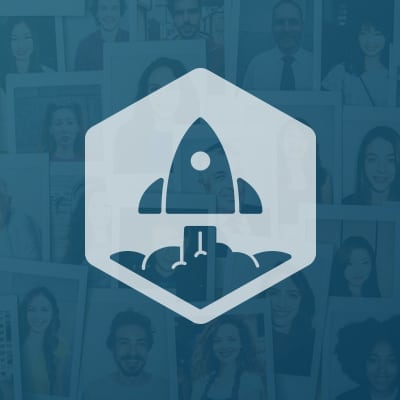As we’re all aware, when your company grows, things start to change dramatically. The way you run a 20-person company is vastly different than how you run a 200-person company.
Caroline Fairchild, New Economy Editor @ LinkedIn, sits down with Matt Straz, CEO at Namely, to discuss what exactly changes at 200 employees and how you navigate those changes. For one, it becomes extremely difficult for the CEO to connect in a meaningful way with everyone across the company so you have to go out of you way to communicate with all of your employees.
Matt also discusses why you should actually avoid press for as long as you can in the beginning, how to think about giving perks and managing how people use them, and why the relationship between a CEO and the head of HR is so important.
And if you haven’t heard: SaaStr Annual will be back in 2018, bigger and better than ever! Join 10,000 fellow founders, investors and execs for 3 days of unparalleled networking and epic learnings from SaaS legends like Jon Miller, David Steinberg, Jennifer Tejada, and Eoghan McCabe. If you don’t have tickets, there’s still time to grab yours today and bring your team from just $999! (Hurry before they’re all gone!) Get tickets here.
TRANSCRIPT
Announcer: Please welcome New Economy Editor of LinkedIn, Caroline Fairchild, and CEO of Namely, Matt Straz.
Caroline Fairchild: Hi, everybody? How’s it going? Feeling good?
Audience: Yeah.
Matt Straz: We’re competing against puppies, right?
Caroline: I think I speak for Matt and I both by saying we’re glad you’re here and not at Yappy Hour. You can compete against a lot of things, but puppies is tough. I’m thrilled to be here today to speak with you guys for a very hyper tactical conversation about what happens after employee 200, with Matt here.
We were just discussing some of the challenges before we got on stage. I’m Caroline Fairchild. I oversee LinkedIn’s publishing platform. Who here has written a post on LinkedIn or has read content on LinkedIn recently? OK. I love seeing that.
Matt is one of my writers and he’s pretty prolific on the platform, sharing content with an audience on LinkedIn as well as a way for him to reach his employees.
To start, I just wanted to ask him a little bit about why blog, why share content on a social network, like LinkedIn, and what are you getting out of that?
Matt: From a business standpoint, it’s certainly good at lead generation. It’s great with partnerships. It’s great from a recruiting standpoint.
One of the side benefits that I didn’t recognize at the time, especially after we crossed the 200 employee mark was that it’s also a really powerful way to connect with employees, and to let them know what you care about, and then have them, obviously, amplify that content and share it.
It has been one of the biggest surprises. If I send an all @namely.com email, maybe, 20, 30 percent people might read it in the first day. LinkedIn content and other social media content is a way to get people engaged with content, especially employees, in a natural way.
Caroline: As Namely has grown, have you found it more challenging to be transparent on social networks? How have you thought about that as the company has grown?
Matt: Amy from marketing would probably never accuse me of being not transparent enough. It’s probably the opposite. She’s back there right now holding on with bated breath to see what happens here.
I’ve always been really transparent. You get a little bit more measured in what you communicate versus the early first couple of years of startups. I pretty much share almost everything, whether it’s one on one with employees or generally to everybody.
Caroline: What’s one thing about you that’s not on your LinkedIn profile that you want to share right now?
Matt: Oh, I went to School for Fine Arts and Design, and I played in a punk band when I was younger. That’s definitely not out on there.
Caroline: Awesome. Let’s backtrack. Give us a little background on Namely and its growth and history up until right now.
Matt: I had founded two other companies. Both of them got acquired in a relatively short amount of time. In both of those companies, I was really frustrated as a mid size company with the lack of great software out there. It’s just that simple.
I didn’t have the information I needed as an employee to, I didn’t feel like, do my job as well as I could have. Whether it was a founder or, once we got acquired in larger companies, I didn’t really have access to the people data to make really good decisions.
That’s how it started. I knew nothing about HR, nothing about payroll, nothing about benefits. Went into it totally ignorant, which in hindsight was probably a good thing, later understanding how complex those businesses are, but that’s how we got started. It was blind, focused on a problem that was driving me crazy and a real desire to do whatever it took to build a significant business.
Caroline: We’ve heard that narrative a little bit in this space where founders have just found a pain point and been like, “There’s got to be a better way,” which is a very different approach than founders who are very specialized in a field. What do you think are some of the benefits to the fact that you identified a pain point without an expertise and were able to drill down into that?
Matt: That big change for us and what we did differently was because I came at it as an employee, I was solving HR problems, but not necessarily for the admins to start with, really focused on the employee first. Up until recently, whether it’s us, Gusto, or Zenefits, nobody had really thought in those terms before.
That ignorance was definitely bliss. It allowed us to have a fresh approach, but it definitely caused some problems down the line that we had to address in the product to make sure that it also worked for admins as well.
Caroline: Focusing on employee is very different when there’s 20 of them versus 200, which you hit the 200 mark last January. Speaking specifically before we move to HR about your role as CEO, what changed the most dramatically would you say last year when you hit that 200 mark in employees?
Matt: I think Jason flagged this in his post when he was promoting this segment. Dunbar’s an anthropologist and, in the 1990s, he said that the maximum limit of relationships that you can have, meaningful relationships that you really connect with other people, is around 150.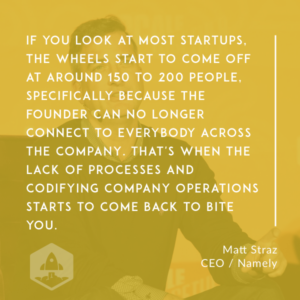
If you look at most startups, the wheels start to come off at around 150 to 200, specifically because that founder can no longer connect to everybody themselves across the company.
That’s when the challenges come up. That’s when the lack of processes, the lack of codifying how you operate as a company, implicitly and explicitly, starts to come back to bite you, because you also have about 200 employees and the chances are at that size that anything that can happen will happen.
People will start to push the bounds of what your culture is, what your policies are if they’re not actually codified in some way.
Caroline: You’re going to give us a specific example of that?
Matt: Sure, PTO. If you tell everyone that you have an unlimited PTO policy, I promise you by 150 to 200 employees, there will be somebody that will test what you actually mean by unlimited. Does that mean that I can go away for three months on a vacation? Does that mean that I can leave the rest of my team in a lurch and just disappear?
I think those things start to come to a head because again the odds are that somebody will push the boundaries of PTO. You’ll also have the other extreme right, where people don’t take enough off that suddenly you realize that somebody is only taking two or three days off the whole year. Those are the things that start to hit you and realize that you’ve got to become a grownup company.
Caroline: What are some of the strategies if you think about, let’s just say, benefit and a benefit is a bell curve and how people treat it. You have an ideal range where you want people to do whatever the benefit is, either use it or not use it. What do you do with the people on either sides and how do you codify the roles in a way that makes it so that bell curve is shaped the way you want to?
Matt: The one thing you can’t do is once you start to see it happening, you need to address it right away. The longer you let it linger and you let those outliers at either extreme go, the more difficult will be to course correct. I think it’s important to deal with it very upfront and honestly as quickly as possible.
That’s the first thing and also just to be really open about it. I found that having meetings like this, having in all hands and communicating it directly is somewhat better than sending out an all hands email all @namely.com and telling everybody what the policy is.
I think what I learned is that sometimes when you codify your policies that way, it’s just really brutal. It’s a brutal way to communicate a new policy. Sometimes doing it in person is a better way to do it. You follow up later on by putting it in writing.
Caroline: Communicating new policies, new benefits is something that tech companies have to do a lot in order to stay competitive and recruit talent. Matt and I were just talking about how crazy some of the benefits are at tech companies now and what prospective employees are expecting from their employer.
Given that environment where there’s free kombucha on tap and there’s ping pong and there is unlimited PTO, how do you think about the role that benefits play in recruiting talent and growing your company to get the best people in the door?
Matt: I think the big learning from me was when we hit about 200 a year, a year and a half ago, I thought that if we just ladled on enough perks, everybody would be happy. Actually, that’s not human nature. There’s actually a point where there’s tremendous diminishing returns to that.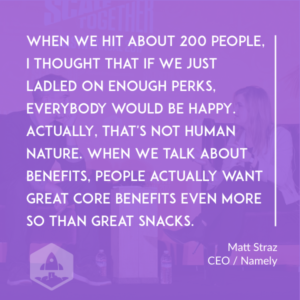
People actually want to work in a place that’s meaningful, that has great communication, that has great managers. When we talk about benefits, they actually want great core benefits even more so than great snacks. Snacks are easy to complain about. That’s a symptom of something deeper that you need to fix in your culture.
[laughter]
Caroline: In like human culture or company culture something, or…?
Matt: I think just generally people will complain about the most superficial things because it’s the easiest thing to complain about. It usually means that there’s something deeper that you need to solve about your business. I think what we found and we have close to 1,000 companies on our platform right now. They’re all about our size.
I think that they all find the same thing, that it’s a balance where you provide a certain amount of perks, but you also have to be really clear about what the mission and what we’re all doing here is, what the purpose of that is.
Caroline: Namely has how many employees now, 300 and…?
Matt: We’re about 350.
Caroline: How has the role between you as CEO and the HR department changed as the company has evolved?
Matt: I would say, as founder, the biggest change is that the product used to be my product. I would just come in everyday and I would say, “If I can just make this product 10 percent better, in the next month, everything will be solved.” Now I realize that the company is my product. Just as products need to be refactored, companies have to be refactored at different points.
You’ve got to upgrade certain parts of it. You can look at the company sometimes like a piece of code. You’ve got to upgrade that and keep it performing really, really well. That is going to change over the life of the company. That was the biggest learning.
I think with HR, the biggest learning is that…I have HR report directly to me. I know a lot of companies have HR report into finance, but I would really urge every founder to have your…Whether it’s your Chief People Officer, your VP of HR, even if it’s your Manager of HR, have them report directly to you. That is my most important partnership right now.
Talent becomes the number one objective once you get over 200 employees. For me, that partnership…I talk with our Chief People Officer probably 10 times a day.
Caroline: Do you think that’s uncommon?
Matt: I don’t know if it’s uncommon, but I would highly recommend it. Once you start to scale and you’re growing as fast as we are, the opportunities around talent and people, I can’t think of something that’s more important at this stage.
Caroline: What are the conversations that you’re having with your Chief People Officer? What are they like and how do you think they’re different than the other people members of your executive leadership team are speaking to that executive?
Matt: We’ve grown a tremendous amount in 24 months. We went from a tiny company to a high growth company in a very short amount of time, 18, 24 months.
When you’re growing that fast, you need to bring as many of your people along with you, and then you also need to bring in people and talent from the outside. Getting that mix right is really, really important. That’s one of the biggest things we’re focused on right now, is what do we have for talent today and what are we going to need in another 24 months when we double in size yet again?
Caroline: When you do double in size, there are people in roles right now who are doing a good job at this stage for the company, and then you up level them and bring in someone with a lot of experience, maybe from another industry, how do you keep that employee happy if they are intending to stay there? What are the conversations like if maybe it’s time for them to leave?
Matt: We’ve got a couple people today that have been with me from the very beginning, two people that have been here three, four, or five years now. What I’ve tried to do is work with them very early on to figure out…
In the beginning, you need generalists to grow your company, but as you grow, you need specialists. It’s an ongoing conversation because roles become more and more specialized over time. Because this was my third startup, I realized early on that our earliest employees are going to be the ones that need the most attention in their career pathing.
Caroline: Let’s talk about your role as CEO. Going from generalist doing everything to specialist, what was the hardest thing for you to let go, whether it’s a meeting or a report or something that you were like, “I actually don’t have the bandwidth to do this anymore.”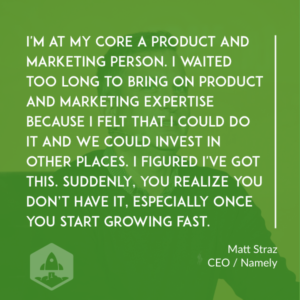
Matt: I’m at my core a product and marketing person. The mistake that I made was that we waited too long to bring on product and marketing expertise because I just wanted to hold on to it, because I felt that I could do it and we could invest in other places. I figured I’ve got this.
What happens is suddenly, you realize, “I don’t got this,” especially once you start growing fast. That was the mistake I made, but the real challenge, I have to say, over the last year, is the degree to which to delegate. You can delegate everything, which isn’t the answer, or you can be micromanaged everything.
I think striking that balance of staying involved in the business while giving people the room to do their job is really important.
Caroline: Do you feel like as CEO, you are responsible…What are you responsible for? I’m not even going to give you the answer.
[laughter]
Matt: I’m responsible for a lot of things, but ultimately, at the end of the day, we’re a venture backed startup. We’ve raised over $150 million, 80 million of it in the last 12 months. We’ve got 350 employees. Every one of them are an investor in our company.
My job, ultimately, is to provide a great return, whether that’s financial or career wise in the coming years. That’s my number one responsibility. I need to provide a return. I need to provide a return no matter how you define that for everybody in the company and everyone who’s invested in the company.
What that means for me is based on the returns that investors would like to see for me to be successful, I need to create a company that has an enterprise value at the end of the day of somewhere between $5 to $10 billion because major investors want to see a significant return. That’s my job.
Caroline: One of your major competitors was in the news a lot last year for having some stumbling blocks in that space, Zenefits. A lot of it had to do with their company culture. Connect for me how company culture ties back to getting return for your investors.
Matt: Quite honestly, they definitely had their challenges and that was unfortunate. For us, we’ve always had a fun culture, but we’ve also been focused on compliance. Keeping those two things balanced is important.
Last year, we brought in a VP of Compliance from MetLife. He had worked in the insurance industry for a decade. We certainly respond to that. Even though we’re growing fast, we never let growth get too out of control. That’s been another core part of our approach.
Somewhere in between, that unsustainable growth and growth that is simply too slow for investors’ patience, we’ve worked to split the difference.
Caroline: For the HR compliance wonks in the audience, about a year ago, you published a post about compliance across states and how complicated the field is, trying to figure out for the people who are in your audience, what’s going on there.
How has HR compliance across states changed in the last year? What are the bigger trends that we’re seeing amongst compliance for HR?
Matt: Certainly, with presidential outcome there, we’ve gone from a period of incredible employee focused regulation last eight years and now, basically as far as we can tell, the total opposite of that. That’s happening at the federal level.
At the state and local level, we see just as much, if not more, employee related regulation happening. It’s been a big focus for us. It means a lot of things to us and our product and also the support that we provide to our customers.
Compliance is as important as ever, just our focus is a bit more on the state and local level right now.
Caroline: President Trump has issued some executive proposals as well as some policies that could directly impact the way that startups and small businesses recruit talent. How are you thinking about that, advising your customers about that? Very early days, but what are you focusing on in that space?
Matt: We invested in creating content around HR and regulation about a year ago pretty significantly, so we publish constantly on this. We cover it and we publish it and we keep our customers informed about the changes. They are changing day by day and I think the future of something like ACA is very, very cloudy.
I think there’s investments that all HR companies made in building out functionality that may not be necessary a year or two from now. The best advice right now is just watch it very carefully. If you want to keep up to date on it, we publish a lot on these topics.
Caroline: One of the other things I wanted to ask you in terms of trends is I think “The Wall Street Journal” came out with an article last week talking about the independent workforce and how it has as many as 20 million people could be working in the gig contract economy.
What does that mean for you as someone whose businesses is around HR software, and how are you thinking about that?
Matt: A big focus for us, we just recently launched a major time and attendance functionality to get more to hourly workforce. We had originally focused on tech companies, media advertising, and primarily, salaried workers.
The big change for us is now focused on this other part of the workforce. It’s a must have, frankly. Everyone needs to pay attention to it. For software companies like ours, it’s just absolutely essential that you address the hourly part of the workforce.
Caroline: This is your third company?
Matt: Yes.
Caroline: A lot of people in the audience probably are leading companies right now and haven’t had the luxury to do it two times before. What are some key learnings that are key stumbling blocks, ways you failed in past that you feel like you’re better suited to be a CEO now?
Matt: Number one way that I failed, it wasn’t necessarily a failure, but it was being open to M&A, and acquisition. The biggest challenge with that, the biggest learning that I had in those two first companies is if you go in with a mindset of building a company to get acquired, you will absolutely get acquired.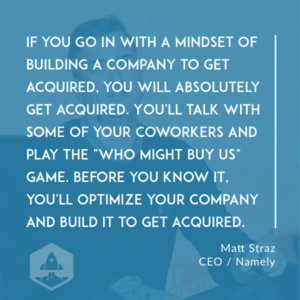
What will happen is that you’ll go out after work and you’ll talk with some of your coworkers and you’ll play the Who Might Buy Us game. Before you know it, you’ll actually optimize your company and build it to get acquired. That happened both times for me.
I went out on a limb in 2012 and we had no employees and no product, and said that we were going to be a public company by the end of the decade. It was a ridiculous, audacious thing to say, but it’s kept us true.
It’s enabled us to say no to M&A offers all along the way. It also enabled me to end up with a board and investors who are also not interested in doing that. That was my biggest mistake, you could say. So far, it’s kept us very true in what we want to accomplish over the next 5 to 10 years.
Caroline: Are there any other parts of the business where you’ve had to fake it til you make it or put a mantra out there without even knowing it’s what…?
Matt: I’ve been to it. No, that’s what a founder does.
[laughter]
Matt: No. I remember, early days, we’d gather together. There was 5 or 10 of us and I said, we’re going to create Workday for the mid market.
Mind you, I was saying this in Brooklyn, New York, where there is absolutely no history of ever building an enterprise software company that competed with anybody. It was ludicrous to say such a thing.
I just fully believed it. I saw that there was a mid market and I saw that mid market not being addressed and I thought that we could do it. I’m glad I was that delusional because it ended up getting us to this point. I think I was right. As crazy as it was to say that back then, it was the right thing to believe. I think that’s what founders are for.
Caroline: You got to this point and have grown so quickly at the same time that one of your competitors has been in the press with a lot of negative news.
Do you have any advice for the leaders in the audience who maybe in the similar situation where they are getting a lot of press attention or a lot of inquiries because of what the competitor’s doing or what’s going on with them?
Matt: I will say that…so it hurt when Zenefits raised $500 million. I had every investor and every potential investor start asking me, “Why can’t you be more like Zenefits?” When I went out to raise the last round, [laughs] they started asking, “How are you different than Zenefits?”
We’ve always been different. One key thing I’d say is, and this is going to be counter intuitive, but initially, avoid the press and stay below the radar as long as you possibly can.
Actually, when that was falling out, we intentionally dodged every single story and inquiry that had to do with that because we just didn’t want to be associated with it. Frankly, I thought it was unfair. Piling on doesn’t make anybody look good in that situation.
We actively didn’t engage with conversations with reporters during that stage. It’s just as important not to be in the news, as it is to be in the news. If you’re going to be in the news, make sure it really matters.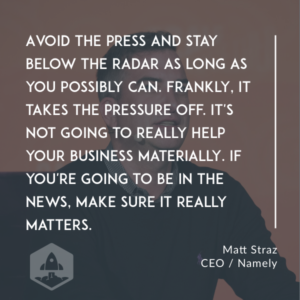
It’s totally fine for us, this is the first time I’ve ever spoken here. I don’t even think I was invited last year. It’s OK to be under the radar for four or five years while you build your company. Frankly, it takes the pressure off. It’s not going to really help your business materially. It really isn’t.
Probably, early press is only going to do bad things. I would say, avoid it, until you’re ready to be able to handle it and you’ve got a great product and a great story.
Caroline: Or tell your own story on LinkedIn and you don’t have to worry about reporters.
Matt: That’s right.
Caroline: What you just said about the investors saying, “Why are you not more like Zenefits? Why are you very different than Zenefits,” is an example where you probably shouldn’t be listening to investors in order to shape your business.
How do you navigate that between the time where you do listen to investors and the times that you don’t?
Matt: That is a great question because there is times where our investors told me things that I didn’t listen to, and I was wrong.
[laughter]
Caroline: It’s a total crap shoot.
Matt: I should have started hiring an executive team way sooner. I tuned them out. They were right. I should have. I should have gotten started a year earlier.
Most of the time, you just have to look inward and see if the advice that they’re giving just makes any sense at all to you. Sometimes, if you’re a first time founder or you’re building a company in a new industry, it’s really hard to not agree with them because you think they know everything.
They’re Sequoia, they’re Matrix, they’re True Ventures, how could they possibly be wrong? What I found is your gut is usually right.
You can sometimes go along with the conversation, even in a board meeting, but it doesn’t mean that you actually have to follow all the way through. Give yourself time to really reflect on, “Is that really the best course of action for the company? Do you really believe that?”
We’ve got advice throughout our history that we should go up market, that we should go down market, that we should go every market. You just have to figure out what it is that want to do.
The mid market focus for us is because I like midsized companies. I don’t want to deal with 10,000 person global company. I just don’t want to deal with that nonsense. We’re focused on the mid market because I love those companies. Everyone who works in our company loves those companies.
You just stay true to that. If you hear things that on paper makes sense like, “Yes, we could become $1 billion company a year quicker if we did that.” If it feels uncomfortable, then just don’t do it.
Caroline: What if you have an investor who’s consistently giving you, I won’t say bad advice, but advice that doesn’t resonate with you, but it’s too late? Has it ever happened to you? Do you feel like you’re able to weed those people out before you take their money?
Matt: I was really fortunate. This was not by grand design. We were a Brooklyn-based enterprise software company in HR five years ago. You can imagine that there are not a lot of people interested in funding that five years ago.
Now, it looks like, “Of course.” Back then, it looked like fairly maybe, perhaps not a great investment.
What happened for us, and I would recommend this to everybody, is make sure that you have the highest quality first investor that you can possibly find. Our first investor was Lerer Ventures. For some reason, they invested in us five years ago.
I knew when they invested that we are going to be OK as a company. I knew at that moment because they were one of the most well regarded seed funds in New York City and incredibly well connected. They introduced us to True Ventures, True Ventures introduced us to Matrix, and Matrix introduced us to Sequoia.
I do have to say that moment where Lerer invested in us, in a weird way, I could see that the next four years playing out. The quality of those early investors will dictate the quality of your future investors.
Honestly, almost every round of financing, I took a lower valuation, so that I could work with those investors. I haven’t really had that situation because I just optimized to having the best investors even if it meant more dilution for me.
Caroline: Great. We’re running out of time, but I do want to bring it back to Namely. Today, the Brooklyn based HR startup is expanding its roots here on the West Coast.
What are the challenges that come with that, with having remote employees, trying to think about performance and culture when you’re not even in the same time zone as some of your people?
Matt: We faced this throughout our lives. Initially, believe it or not, we were a small company. Some of our people were in Manhattan and some were in Brooklyn. We had to bring everybody together in Lower Manhattan, which was culture shock.
Caroline: [laughs] Total culture shock.
Matt: Absolutely, especially when it’s Brooklyn engineers going to Lower Manhattan.
You have to work through those shocks. We now have a significant West Coast office on Market Street. We have a growing office in Austin. The thing is that what you have to recognize is the sense of being remote, or excluded, or outside of certain information is a natural state.
If somebody works 3,000 miles away from headquarters, that’s a natural inclination to feel like you’re missing out in some information.
I publish a ridiculous amount. As you know, I publish on LinkedIn. We have a feed on our product I publish weekly. We do a monthly all hands that get broadcasts across the country to all of our employees. Even then, there is the sense that they might be missing out on something.
I just think that you have to go that extreme lengths to make everybody feel included. As a founder, you’re an ambassador to the entire company. You’ve got to spend time in every office as much as you can.
Caroline: Great. Thank you so much, Matt.
Matt: Sure.
Caroline: We’re all ready to go grow our businesses to 200 employees. Thanks.
Matt: Thank you.
[applause]
Transcription by CastingWords

